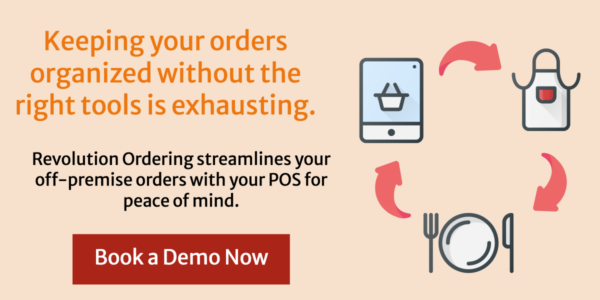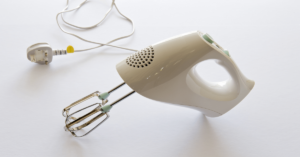Restaurant Equipment List: 26 Must-Have Appliances & Gadgets
Keeping up with restaurant industry trends can be a challenge. Staying on top of your game means having the right restaurant equipment for the job.
To help you out, we’ve put together this comprehensive checklist of must-have restaurant equipment for your business. Whether you’re opening a restaurant or refreshing your existing one, this list has everything you need to get started. Read on.

Restaurant Equipment
Here are the 25 items for your restaurant equipment list You can use this important restaurant equipment for both quick-service and full-service restaurants:
1. Microwave

Without doubt, a microwave is an essential part of a quick service restaurant, a ghost kitchen, and even a Michelin-star restaurant. This versatile equipment can steam cook, reheat pre-cooked items, or defrost. A good microwave will save you time and hassle in the kitchen, so it’s worth investing in a quality model.
2. Coffee Maker

Consider these items before you go out and buy a multi-thousand dollar espresso machine. First, you’ll want to decide what type of coffee maker best suits your needs. There are automatic drip coffee makers, espresso machines, French press coffee makers, and more.
Once you’ve decided on the type of coffee maker you need, you’ll need to consider the size. If you have a small restaurant, you’ll want to ensure you get a compact model that doesn’t take up too much counter space.
You’ll also want to consider the features you need in a coffee maker. Do you want a machine that can make multiple cups at once?
Once you’ve considered all of these factors, you’ll be able to narrow down your choices and find the perfect coffee maker for your restaurant.
3. Food Processors

There are four main types of food processors: batch bowl, continuous feed, combination, and vertical cutter mixers.
- Batch bowl food processors are ideal for small to medium-sized batches of food. They have a capacity of 2-10 quarts (1.9-9.5 liters) and come with various attachments for tasks such as chopping, slicing, shredding, and kneading dough.
- Continuous feed food processors are designed for larger batches of food. These machines come with attachment options for chopping, slicing, and shredding. They have a hopper that can hold up to 20 quarts (19 liters) of food and a chute that allows you to add more ingredients while the machine runs..
- Combination food processors are a combination of batch bowls and continuous feed processors. They have a small batch bowl capacity (2-4 quarts or 1.9-3.8 liters) with a continuous feed chute.
- Vertical cutter mixers are designed for large batches of wet or dry ingredients. They have a cylindrical container that holds up to 100 quarts (95 liters) of ingredients and a vertical mixer blade that spins at high speeds to chop, blend, or puree the ingredients. These machines contain attachments for chopping, blending, pureeing, and kneading dough.
4. Griddle

A griddle is a flat cooking surface that is heated by either an open flame, electric heating element, or gas burner. Griddles are used in various settings, from commercial kitchens to backyard cookouts.
Restaurant griddles are made from cast iron or steel and come in multiple sizes to accommodate different needs. When choosing a restaurant griddle, it is important to consider the type of food you will be cooking on it, and the size and capacity you need.
5. Deep Fryer

Deep fryers are, and have been, an essential component of restaurants for many years. This is especially true for the fast food and fast casual chain. But, it applies equally to those who will need to serve those deliciously favored fried foods.
While there are many different types and models of deep fryers on the market, they all share some common features. The most important thing to consider when purchasing a deep fryer is the size of the unit. Commercial deep fryers come in various sizes, from small countertop units to large floor-model fryers. Choosing a fryer that can accommodate the volume of food your restaurant serves is essential.
Another important consideration when choosing a commercial deep fryer is the type of fuel it uses. Most deep fryers use either natural gas or propane, but electric models are also available. Each fuel format has its particular pros and cons, so choose one that suits your needs.
%2520(1).png)
6. Kitchen Supplies and Serving Ware
×

There are a lot of different kitchen supplies and serving ware that you might need for your restaurant. Some of the things that you might need include:
- Pots and Pans: A good set of pots and pans is a must for chefs such as the executive chef and Michelin star chefs. You’ll need a variety of sizes and shapes to accommodate all the dishes you’ll be preparing.
- Tongs, Spatulas, and Serving Spoons: These are essential for cooking and serving food. Tongs are great for flipping burgers or chicken, while spatulas are perfect for eggs and pancakes. Serving spoons come in handy when dishing out food onto plates.
- Glassware: If you’re going to be serving drinks such as wine, cocktail drinks, or great rum drinks in Friday drink specials, you’ll need glassware. Choose glasses that are the appropriate size and shape for the type of drink you’ll be serving.
- Dishware: plates, platters, bowls, serving plates, and bowls.
- Flatware: knives, spoons, forks, serving utensils
- Dinnerware accessories: charger plates, ramekins, sauce cups, dessert dishes, plate covers, bread and butter plates, coffee mugs, teacups, and saucers.
- Display serving: baskets, appetizers, and tasting dishes.
- Linens: cloth napkins and tablecloths.
The amount of serving ware you should buy depends entirely on your restaurant size and the types of menu you’re planning on serving.
Before ordering all your dishware, ask yourself the following questions:
- What is your table turnover rate?
- How many seats are in your restaurant?
- What types of dishes are you serving?
- How many people do you expect on your busiest days and times?
- What are the most popular dishes for your restaurant’s customer?
- What types of dishware do those popular plates require?
7. Ovens

The many kinds of restaurant ovens could exhaust some people. And, beyond that, each comes with their own particular and unique advantages.
Here is a quick overview of some of the most common types of ovens you’ll find in restaurants:
- Commercial ovens: These are designed for large-scale cooking and are often used in institutional settings like schools and hospitals. They’re usually very durable and can handle high volumes of food, but they’re also expensive and may require special installation.
- Convection ovens: Convection ovens use circulating fans to distribute heat, which makes them ideal for baking evenly. They’re also more energy-efficient than traditional ovens, making them a popular restaurant choice.
- Combination ovens: Combination ovens are a combination of a convection oven and a traditional oven, and can be used for both baking and cooking. They’re perfect for restaurants that want the flexibility to do both, but they’re more expensive than either type of oven on its own.
- Pizza ovens: As you might expect, pizza ovens are specifically designed for cooking pizzas. They usually have high heat settings and a stone surface that helps create a crispy crust.
- Conveyor ovens: Conveyor ovens are another type specifically designed for large-scale cooking. Their belts move food through the cooking chamber where they cook large volumes of food, quickly and evenly.
8. Storage Containers
×

Restaurants need a variety of storage containers to keep their ingredients fresh and organized. Here are some of them:
- Vegetable crispers are great for storing leafy greens and other vegetables.
- Large ingredient bins can hold bulk items like flour or sugar.
- Kitchen canisters are perfect for storing spices and other small items.
- Dough boxes are ideal for storing dough or other baking supplies.
- Food storage containers should be used to store leftovers or prepackaged meals.
9. Sinks

Several sink varieties exist to serve the needs of restaurants. When you consider them, you’ll see how each sink serves its purpose well. Let’s take a look:
- Compartment sinks are the most common type of sink used in restaurants. They typically have three or four compartments, which can be used for washing dishes, rinsing fresh produce, or prepping food.
- Bar sinks are smaller than compartment sinks and are typically used for washing glasses and preparing a mixed drink.
- Disposal sinks are designed to be used with a garbage disposal unit and are typically used for cleaning up after meals.
- Drop-in units are sinks that can be dropped into a countertop or other surface. They are typically used in smaller restaurants where space is limited.
- Handwashing sinks are designed for washing hands and are usually located in the restroom area of the restaurant.
- Mop sinks are designed for cleaning floors and are typically located in the back of the restaurant.
- Portable sinks are self-contained units that can be moved around as needed. You will definitely see these used at large, catering events.
10. Ice Makers

Ice makers will help any restaurant or food service business. They offer ice for drinks and keep food chilled. There are a few different types of ice makers:
- Freestanding units are typically small and compact, making them easy to fit in any kitchen or storage space. These tend to be more affordable than some other common alternative, making them a smart solution for businesses on lean budgets. However, freestanding units can be less reliable than other types of ice makers and may require more maintenance over time.
- Built-in ice makers are another option for restaurants and food service businesses. These units are installed into the counter or storage space, making them more permanent than freestanding. Built-in ice makers are typically more expensive than freestanding, but they are also more reliable and require less maintenance.
- Portable ice makers are helpful to businesses that have their coolest ingredients on-the-go. These freestanding units have wheels that make them easy to transport. Portable ice makers can be less reliable than other types of ice makers and may require more maintenance over time.
- Ice machines are the most expensive type of ice maker but are also the most reliable and require minor maintenance. Ice machines are typically large and bulky, making them difficult to move around. They also need to be plumbed into a water line, which can be challenging for some businesses.
No matter what type of ice maker you choose, it is important to ensure that it is properly maintained. Regular cleaning and descaling will help to keep your ice maker running smoothly and prevent problems down the road.

11. Mixers

Three main types of mixers are used in restaurants: hand mixers, countertop mixers, and floor mixers.
- Hand mixers are the most common type of mixer used in restaurants. They are small and portable, making them great for mixing ingredients or whipping cream.
- Countertop mixers are larger than hand mixers and are usually bolted to the countertop. They are often used for heavy-duty tasks, such as kneading dough or mixing large batches of ingredients.
- Floor mixers, the largest type of mixer, are used for commercial applications, such as baking and catering.
12. Sharpening Stone

Sharpening stones serve most restaurant kitchens in a classic display of utility. It keeps knives sharp and in ready-to-cook condition. The stone can be used on any type of knife, including serrated blades.
13. Restaurant Point of Sale
One of the essential pieces of restaurant equipment is the point of sale (POS) system. A POS system helps streamline operations and keep track of sales, customers, and inventory. With some research, you can find a POS system that fits your needs and budget.
The first step is determining what features you need in a POS system. Do you need something such as restaurant POS integration? Are you looking for payment processing software that offers and integrates with contactless payments? Do you need a system with inventory tracking features?
Know what features you need, and narrow down your options. There are POS systems designed specifically for restaurants, so if you’re looking for restaurant-specific features, that’s an excellent place to start.
14. Steam Table
A steam table is a large, flat-topped piece of equipment that is used to keep food warm. These devices are powered by electricity or gas, and use steam to maintain a consistent temperature.
Steam tables are critical parts for buffet-style restaurants: they allow customers to serve themselves without having to wait for food to be cooked fresh. They are also the frequent choice for businesses in catering operations, keeping food warm for long periods of time.
16. Safety Equipment
There are a few pieces of equipment that are essential for any restaurant to have in order to ensure the safety of both employees and customers.
Fire extinguishers, first aid kits, and rubber floor mats are some of the most critical for customer safety, which is not a situation to be unprepared for. Wet floor signs and aprons can help protect against slips or falls, while oven mitts and goggles can stop burns. Hairnets and security cameras can help keep food safe from contamination.
Using the proper safety equipment in your restaurant is vital for compliance. Think of those health and safety regulations before you go out and shop for the right protective equipment though. Ensure you cover the basics as well as local and legal expectations.
17. Slicers

There are a few things to consider when choosing a slicer for a restaurant.
- Select between the automatic or manual slicer. Automatic slicers are more expensive, but they’re also faster and easier to use. If speed is important, then an automatic slicer is the way to go.
- Choose the right blade size. If you’re slicing meat or cheese, you’ll need a larger blade. For smaller items like vegetables, a smaller blade will do the trick.
- Decide if you want a light, medium, or heavy-duty slicer. Heavy-duty slicers can handle tougher jobs, but they’re also more expensive. If you only need to slice occasionally, a light-duty slicer will suffice.
18. Cooking Equipment

Any restaurant worth its salt is going to have a well-equipped kitchen, and that means having the right pots and pans (of all sizes) with lids, spoons for mixing and tasting, chef’s knives, mixing bowls, whisks, spatulas, ladles, tongs, baking pans, sheets, or roasting pans, as well as towels and rags.
These are just the basics. Every chef will have their own specific list of must-have items. With these in place, you’ll be able to handle just about anything that comes your way.
.png)
19. Commercial Toaster

Commercial toasters are designed for high-volume toast production and usually have wide slots to accommodate multiple pieces of bread at once. Restaurant kitchens typically use conveyor toasters, which can toast up to 800 slices of bread per hour. But other types of commercial toasters are available as well, such as pop-up and drawer toasters.
20. Freezers and Refrigerators

Commercial refrigeration and freezers in restaurants are typically used to store food that needs to be kept cold. This might include items like meat and fish, dairy products, and wholesale produce. In order to keep the food at a safe temperature, the appliances need to be kept in good condition and properly maintained.
21. Kitchen Display System (KDS)

A Kitchen Display System (or, KDS) is a restaurant technology that streamlines front-of-house and back-of-house operations. In the usual arrangement, it consists of a display screen that shows real-time information about orders, kitchen staff performance, and other data.
Many restaurant owners find that a KDS improves efficiency and communication in the kitchen, ultimately leading to better customer service. In addition, a KDS can help reduce costs and manage restaurant food waste associated with inaccurate orders.
22. Storage Racks and Shelves

Storage racks, shelves, and bins offer a resource for all the supplies that keep you in business, including food, utensils, and other necessary items. Without proper storage, your restaurant could quickly become cluttered and disorganized, making it difficult to find what you need when you need it.
23. Food Prep Counters and Cutting Boards

In a restaurant setting, you want to make sure that you have surfaces that are easy to clean and sanitize. That’s why many restaurants choose to use stainless steel countertops. Stainless steel, being durable and resistant to bacteria, makes for a perfect material in your food preparation area.
For cutting boards, there are a few things to keep in mind. First, you’ll want to choose a material that is easy to clean and won’t absorb bacteria. Wood cutting boards are a popular choice, but they need to be properly cared for in order to prevent bacterial growth. Bamboo cutting boards are also a good option because they’re naturally antibacterial. Plastic cutting boards are another story: they frequently harbor bacteria and present difficulty during cleaning.
No matter what material you choose for your food prep tables and cutting boards, keep them clean and sanitized. Regular cleaning with hot water and soap will help prevent bacteria growth. If you’re using wooden cutting boards, it’s also important to oil them regularly to prevent them from drying out and cracking.
24. Ranges and Ventilation

There are two types of ranges commonly used in restaurants: gas ranges and electric ranges.
Gas ranges are usually more expensive than the electric range, but comes with the benefit of speed and control. Electric ranges, on the other hand, stay easier to maintain, especially in new restaurants who don’t have much time for maintenance. They are, however, slower to heat up and may not offer as much control over the cooking process.
25. Gas or Electric Grill

Which is better to use in a restaurant: a gas or electric grill?
Some factors you may want to consider include:
- How much space do you have?
- How often do you need to use the grill?
- What kind of foods will you be cooking on the grill?
- Do you have access to natural gas or propane?
Here are some pros and cons of each type of grill:
Gas grills:
- Heats up quickly
- Allows for more precise temperature control
- Used indoors or outdoors
- Easy to clean
Electric grills:
- Heats up slowly
- Uneven temperatures
- Not used outdoors
- Challenging to clean
26. Washing Equipment

There are a few different types of washing equipment that you will need to keep your establishment clean. This includes brushes for your griddles, mops, sponges, rags, and commercial-grade cleaning products.
How to Source Your Restaurant Equipment
Here are a few tips on how to source your restaurant equipment:
- Decide what type of equipment you need.
- Research online and offline retailers.
- Compare prices and features.
- Place your order.
- Set up your equipment.
Opening a restaurant can be a lot of work, but sourcing your restaurant equipment doesn’t have to be a hassle. Following these tips, you can find the right retailers and get the best deal on your needed equipment.
Frequently Asked Questions About Restaurant Equipment
What Are the 4 Basic Types of Restaurants?
If you’re thinking about opening a restaurant, it’s important to first understand the different types of restaurants that exist. There are four basic types of restaurants:
- Fast food
- Casual dining
- Fine dining
- Specialty
What Are the Four Categories of Kitchen Equipment?
These are the four basic categories of kitchen equipment:
- Food Storage
- Food production
- Maintenance
- Special Equipment
Each category has its own unique set of items that are essential for a well-functioning kitchen.
What Do Restaurants Need the Most?
There’s no doubt that restaurants are businesses that need to make a profit to survive. But what do they need the most in order to be successful?
- Customers: A restaurant cannot survive without customers coming in and buying food or drinks.
- Good employees: Employees who are passionate about their work and who provide great customer service. They also need quality ingredients and suppliers who can provide them with fresh, delicious food.
- Effective marketing: They need to let potential customers know about their business and why they should choose them over other options.
If a restaurant can focus on these things, then they will be well on their way to success.
What Main Equipment is in a Restaurant?
With your essential restaurant kitchen equipment checklist, you should cover each area of business service:
- Professional ovens
- Ventilated ranges
- Food processors
- Food prep items
- Freezers and refrigerators
- Safety equipment
But, don’t forget the seamless technology and restaurant software that will help you reach more customers with less effort. Consider POS hardware, restaurant CRM software, food costing software, and integrated online ordering solutions before launch as well.
What are the Inventory Items of a Restaurant?
In the foodservice and hospitality industry, inventory is almost everything needed to give great customer satisfaction like food ingredients, restaurant equipment, and even uniforms.
Some inventory items you’ll find common to the full-service and fast food industry include:
- Raw foods
- Dry goods
- Spice storage
- Liquor and wine
- Beverages and tea
- Linens and uniforms
With so much to manage, restaurant inventory costing methods and inventory management systems may speed and streamline your re-ordering and stocking processes.
Explore Revolution Ordering for Business Growth
When choosing the equipment for your restaurant, it is important to consider what will best meet your needs.
The right equipment and restaurant technology can help you run your business and become a successful restaurant owner. The wrong equipment can cause frustration and waste time and money. Take the time to research your options and choose wisely so that you can focus on what you do best: serving delicious food!
When you’re ready to enable off-premise business through online ordering software, demo Revolution Ordering with one of our specialists
